2002
Well another year in theMediterranean is drawing to a close. We have once again returned to Kemer
Marina in Turkey for the winter and have
settled into the busy live aboard lifestyle.
This summer was meant to be a quiet one
but as usual we overdid it and ended up traveling vast distances. We traveled home to Australia in Oct
2001 and spent many months languishing in the bosom of familiar surroundings,
good friends and family, delicious food and unbelievably tantalizing wine.
During our time in Australia we gathered together a
hoard of boat bits and other must haves like a supply of Vegemite and staggered
to the airport where we were told that we were a bit overweight with our
luggage, well surprise, surprise.
But the charge was not too horrendous and so together with our 100 odd kg
of luggage we flew back to Athens and after a bit
of luck with customs we picked up a hire car and made it out of Athens in one piece. The
road system is a complete shambles and so we did wonder how the Olympics will be
run amidst the chaos that is Athens.
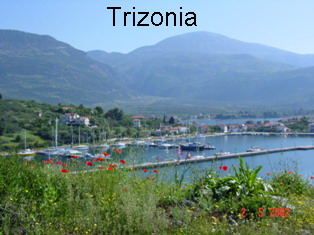
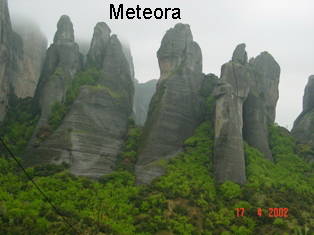 We found the boat safe and sound and we only lost 4 fenders during our
absence, which we considered a small price to pay for 6 months marina fees. We used the hire car to travel around
inland Greece for a week in
the April and we now believe that the best time to visit Greece is in the
Spring when it is not too hot and there are not too many tourists. The wild flowers were out in force and
there was still snow on the highest mountains. Highlights of the tour were
Meteora to the north and the Peloponnese in the
south. Meteora, from which the word meteor comes, is a place with high rock
pinnacles on the top of which are perched a number of monasteries. These guys
must have been seriously worried about their safety to go the extraordinary
effort of putting their buildings on the top of these peaks but they did and
they only had nets and ropes to connect them with the outside world. And, of
course, the Peloponnese, the home of the
delicious Kalamata olive, the original site of the Olympics and the Spartans.
The Kalamata trees are different to the standard olive tree with greener and
larger leaves. Overall, the wild scenery and little isolated towns of the
Peloponnese were refreshing after the more
well-travelled tourist trails. The drivers of Greece all have
a death wish, which was fine as long as they didn't try to include us. They
overtook on blind corners, in the face of oncoming traffic, in fact, at any time
at all and I am pleased to say that Stephen's driving allowed us to anticipate
them all and make it safely back to the boat and begin to put the boat back into
working order. We were planning to
get away by the end of April but we hadn't reckoned on Greek Easter. We just couldn't miss the most important
religious festival of the year so we stayed and celebrated Easter in
Greece. It is a time for visiting relatives and
of course much partying and eating. A bit like our Xmas, except the Greeks are
far more religious about the holiday. We were on the small island of Trizonia with a population of maybe 50 people
and 100 cats for 51 weeks of the year but at Easter the population swells to
closer to 1500 and the sleepy ferry drivers work around the clock to keep up
with the comings and goings of the happy throngs. We watched the services in the
quaint Greek Orthodox Church as we tried to avoid the kids and the men (who
behaved even worse than the kids) throw huge firecrackers into the crowd. Some
of you reading this may remember back to the good old days of the threepenny and
6 penny bomb – well the Greeks still have them and there were quite a few
rubbish bins and cats a bit worse for wear by the end of the Easter Weekend. The
candle carrying ceremony at the end of the midnight service on Easter Sunday was
moving. The candles are lit by the priests and the people try to carry them back
to their houses without them blowing out. It symbolizes the hope of the
resurrection and signals the start of a feast .The feast is lamb based and lasts
for most of the night and after a short break begins again the next afternoon.
Boy, those Greeks sure know how to party.
We found the boat safe and sound and we only lost 4 fenders during our
absence, which we considered a small price to pay for 6 months marina fees. We used the hire car to travel around
inland Greece for a week in
the April and we now believe that the best time to visit Greece is in the
Spring when it is not too hot and there are not too many tourists. The wild flowers were out in force and
there was still snow on the highest mountains. Highlights of the tour were
Meteora to the north and the Peloponnese in the
south. Meteora, from which the word meteor comes, is a place with high rock
pinnacles on the top of which are perched a number of monasteries. These guys
must have been seriously worried about their safety to go the extraordinary
effort of putting their buildings on the top of these peaks but they did and
they only had nets and ropes to connect them with the outside world. And, of
course, the Peloponnese, the home of the
delicious Kalamata olive, the original site of the Olympics and the Spartans.
The Kalamata trees are different to the standard olive tree with greener and
larger leaves. Overall, the wild scenery and little isolated towns of the
Peloponnese were refreshing after the more
well-travelled tourist trails. The drivers of Greece all have
a death wish, which was fine as long as they didn't try to include us. They
overtook on blind corners, in the face of oncoming traffic, in fact, at any time
at all and I am pleased to say that Stephen's driving allowed us to anticipate
them all and make it safely back to the boat and begin to put the boat back into
working order. We were planning to
get away by the end of April but we hadn't reckoned on Greek Easter. We just couldn't miss the most important
religious festival of the year so we stayed and celebrated Easter in
Greece. It is a time for visiting relatives and
of course much partying and eating. A bit like our Xmas, except the Greeks are
far more religious about the holiday. We were on the small island of Trizonia with a population of maybe 50 people
and 100 cats for 51 weeks of the year but at Easter the population swells to
closer to 1500 and the sleepy ferry drivers work around the clock to keep up
with the comings and goings of the happy throngs. We watched the services in the
quaint Greek Orthodox Church as we tried to avoid the kids and the men (who
behaved even worse than the kids) throw huge firecrackers into the crowd. Some
of you reading this may remember back to the good old days of the threepenny and
6 penny bomb – well the Greeks still have them and there were quite a few
rubbish bins and cats a bit worse for wear by the end of the Easter Weekend. The
candle carrying ceremony at the end of the midnight service on Easter Sunday was
moving. The candles are lit by the priests and the people try to carry them back
to their houses without them blowing out. It symbolizes the hope of the
resurrection and signals the start of a feast .The feast is lamb based and lasts
for most of the night and after a short break begins again the next afternoon.
Boy, those Greeks sure know how to party.
So after recovering from the excesses of
Greek Easter we set off westwards through the Corinth Gulf towards the Ionian
Sea and anchored in some delightful little bays with white sandy bottoms and
aquamarine seas on islands called Ithaca (home to Ulysses), Paxos and Antipaxos
and found the fabled River Styx on the Greek mainland. We visited Lefkas,
Preveza and Corfu
Islands as we traveled
northwards.
We had been considering visiting
Albania on our way up to
Croatia and as we had the phone
numbers of the mayor of Sarande and the commander of the Albanian Navy, we gave
them a call and asked if we were allowed to come. They were a bit surprised at first but
quickly recovered and told us we were most welcome. We were still a bit hesitant as we set
off for Albania but as it was
only 11 NM away from Corfu and so we dropped
in. As we approached the port of Sarande, we called up their port control
and asked for permission to enter.
There was a moment of silence and then an incredulous voice came back,
"You want to come here?" We said we
did and so it was that we were met at the wharf by a shipping agent, the harbour
master, port police, etc, who all piled on board and seemed fascinated by the
whole event. The formalities were quickly completed and they even promised us a
courtesy flag when we explained that there were none to be had in
Greece (the Greeks had mentioned that
the Albanians were known to have two heads so why would you go there). So far so good, the next step was to try
to get some Albanian currency, Leks. No problem they said you just go up to the
main street. So off we walked but after some distance and no sign of a currency
exchange we stopped at a restaurant and explained that we would love to have
lunch in their establishment but first we must get some money. The young lad
points across the road and says the moneychanger is the man with a calculator in
his hand on the other side of the road.
Sure enough, as we approach him he asks us how much we want to change and
so we receive our first hand full of Leks, then had a delicious lunch and headed
back to our boat. We found the local children had adopted our dinghy as a mobile
diving platform and they were most put out when we asked for it
back.
Within an hour of being in
Albania we were interviewed
by a Finnish film company who asked why we had come to Albania and if
we liked it. So one day you may be watching a travel log on Albania and
there will be our smiling faces. The travel guide assisting the film crew
offered his services and so we arranged a car and driver for a couple of inland
trips. It was suggested that we have a driver because until a few years ago
nobody could own or drive their own car and they still didn't have to pass
driving tests so the rules of the road were a bit laissez
faire.
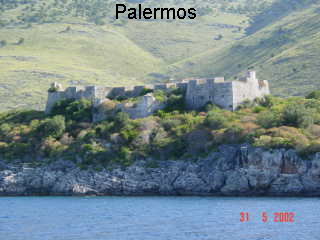
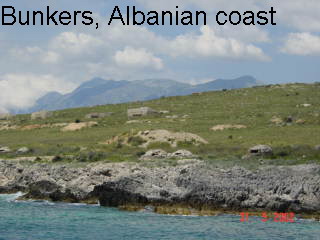 The first day we visited an ancient
site called Butrint and then an amazing spring called the Blue Eye. The Blue Eye
is the gushing start of a surface stream. Watching the huge amounts of water well
up from unfathomable depths was fascinating. The next day we went to the ancient city
of Gjirokastra. It is set on a steep hill overlooking a
wide and fertile valley. Above the
town is an immense citadel in an excellent state of preservation. It is now a
war machine museum and because tourists were so rare the driver had to go and
find someone to open up. We then visited an old house, which is an ethnological
museum. It was interesting that the
house resembled an Ottoman Turkish house with the lowest level for storage of
produce for winter, the next level had the kitchen and summer rooms and the top
floor was for winter. Many family
units may live in one house and each family room is used for sleeping and during
the day the beds are folded away into a cupboard and the space is used for
sitting, reading, handicrafts, etc. With the aid of the driver we found a
restaurant for lunch. The driver
went off to visit his daughter who was attending college nearby and so we
settled in for an interesting lunch.
There was only one other table occupied but the 6 guys and one lad were
having a great time eating and then drinking some of the local fire water and of
course it wasn't long before we were invited to join in the festivities. We had
Graham and Lyn, a New Zealand couple with us, and Graham began to
enjoy the local drop. The
restaurant owner called in his daughter to assist in the translating and so it
wasn't long before Graham was proposing to the daughter and everyone was
understanding each other much better – thank goodness we didn't have to drive.
We left the port of Sarande shortly afterward and visited a couple of other
Albanian ports on our way north. A
couple of notable items about Albania were, one, that the
countryside is literally peppered with pillboxes. Apparently there are 750,000 throughout
Albania and, two; the country is full
of new model Mercedes. We found
this a bit strange in a country that is so poor, but it was explained to us that
not all cars are paid for!
The first day we visited an ancient
site called Butrint and then an amazing spring called the Blue Eye. The Blue Eye
is the gushing start of a surface stream. Watching the huge amounts of water well
up from unfathomable depths was fascinating. The next day we went to the ancient city
of Gjirokastra. It is set on a steep hill overlooking a
wide and fertile valley. Above the
town is an immense citadel in an excellent state of preservation. It is now a
war machine museum and because tourists were so rare the driver had to go and
find someone to open up. We then visited an old house, which is an ethnological
museum. It was interesting that the
house resembled an Ottoman Turkish house with the lowest level for storage of
produce for winter, the next level had the kitchen and summer rooms and the top
floor was for winter. Many family
units may live in one house and each family room is used for sleeping and during
the day the beds are folded away into a cupboard and the space is used for
sitting, reading, handicrafts, etc. With the aid of the driver we found a
restaurant for lunch. The driver
went off to visit his daughter who was attending college nearby and so we
settled in for an interesting lunch.
There was only one other table occupied but the 6 guys and one lad were
having a great time eating and then drinking some of the local fire water and of
course it wasn't long before we were invited to join in the festivities. We had
Graham and Lyn, a New Zealand couple with us, and Graham began to
enjoy the local drop. The
restaurant owner called in his daughter to assist in the translating and so it
wasn't long before Graham was proposing to the daughter and everyone was
understanding each other much better – thank goodness we didn't have to drive.
We left the port of Sarande shortly afterward and visited a couple of other
Albanian ports on our way north. A
couple of notable items about Albania were, one, that the
countryside is literally peppered with pillboxes. Apparently there are 750,000 throughout
Albania and, two; the country is full
of new model Mercedes. We found
this a bit strange in a country that is so poor, but it was explained to us that
not all cars are paid for!
Our last port of call in
Albania was Durres, a modern port with
an ancient town behind. At this
port the harbour master was so concerned about the possibility of thieving that
he insisted that one person remain on board the boat at all times. We stood watch all night and decided to
leave early the next morning for Croatia about 100Nm away.
Our arrival in Croatia at dawn the day after and our
clearing into the country was easy if a bit expensive. We were charged nearly AUD$400 for a 12
month cruising permit. We walked
the city wall of Dubrovnik and wandered the old streets and the
port area. The streets and houses
are built from a particular light coloured stone and the roofs all have orange
tiled roofs. The city suffered
extensive damage during the recent war and there was still a lot of repair work
being undertaken although the most obvious damage has been
repaired.
We were anchored in Gruz, which is the
new harbour for Dubrovnik, and the guy collecting
fees had spent some time in Australia, so he could tell a bit
about the war and its effects on people.
Pretty sad mostly. Our anchor did
not set right while we were at Gruz and when we pulled it up we found a piece
of partly burnt sail hooked on it.
Obviously a legacy of the war.
From
Dubrovnik
we meandered amongst the myriad of
islands just off the coast and spent a bit of time just swimming and generally getting used to
being mostly naked.
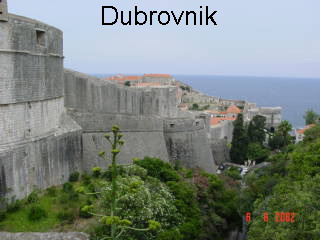
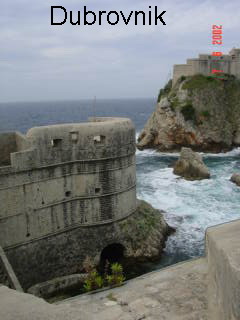 We were trying to arrange a rendezvous with my sister Sue and her
daughter Edie and so while we were waiting we decided to sail up to Venice and see the sights
before it got too hot and busy. A
good move we thought, but we ignored the weather forecast and so of course we
got to experience the north Adriatic Sea at a
most unkind time. At about 40Nm out
of Venice and 4
o'clock in the morning we encountered a front coming through and as the wind
changed direction we found ourselves in seas that would have done a washing
machine proud. In hindsight we
worked out that this amazing sea was whipped up because the depth is only about
50-20 metres for the last 100 miles of the Adriatic Sea. It was the
closest I have come to being sick – something to do with trying to clean up the
coffee that spilled on the floor when the cupboard door burst open as we were
hit by a particularly nasty wave. Luckily, the tide was with us and so we were
able to keep up a respectable boat speed (7 kts) and make it into Venice in time for lunch.
On our approach to the canal entrance we saw a large passenger ferry called the
Duchess of Dubrovnik rolled over so far by the seas that we could see its
topsides and we laughed as we thought of the coffee cups flying across the
dining room. The wind was still hooting as we tied up to poles at the end of the
Grand Canal but our view from that location was
unbelievable, I felt that I had stepped into Bannister Fletcher's History of
Architecture.
We were trying to arrange a rendezvous with my sister Sue and her
daughter Edie and so while we were waiting we decided to sail up to Venice and see the sights
before it got too hot and busy. A
good move we thought, but we ignored the weather forecast and so of course we
got to experience the north Adriatic Sea at a
most unkind time. At about 40Nm out
of Venice and 4
o'clock in the morning we encountered a front coming through and as the wind
changed direction we found ourselves in seas that would have done a washing
machine proud. In hindsight we
worked out that this amazing sea was whipped up because the depth is only about
50-20 metres for the last 100 miles of the Adriatic Sea. It was the
closest I have come to being sick – something to do with trying to clean up the
coffee that spilled on the floor when the cupboard door burst open as we were
hit by a particularly nasty wave. Luckily, the tide was with us and so we were
able to keep up a respectable boat speed (7 kts) and make it into Venice in time for lunch.
On our approach to the canal entrance we saw a large passenger ferry called the
Duchess of Dubrovnik rolled over so far by the seas that we could see its
topsides and we laughed as we thought of the coffee cups flying across the
dining room. The wind was still hooting as we tied up to poles at the end of the
Grand Canal but our view from that location was
unbelievable, I felt that I had stepped into Bannister Fletcher's History of
Architecture.

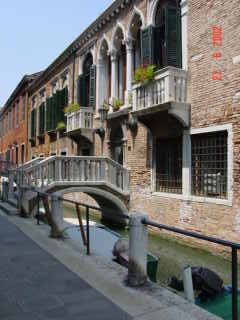
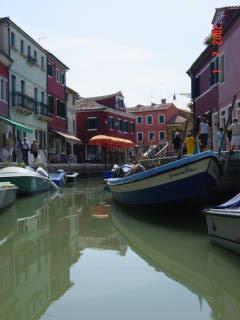 We stayed for a couple of days in this spot and roamed the city, enjoying
the glorious food and the sights until we found that we had to move or pay Euro
55 per night, so we moved. As we
moved a spectacular thunderstorm rolled through and there we were cruising along
a canal with wind driven rain giving us almost zero visibility and nowhere to
go. Great, we thought, what do we
do now.
We stayed for a couple of days in this spot and roamed the city, enjoying
the glorious food and the sights until we found that we had to move or pay Euro
55 per night, so we moved. As we
moved a spectacular thunderstorm rolled through and there we were cruising along
a canal with wind driven rain giving us almost zero visibility and nowhere to
go. Great, we thought, what do we
do now.
But the storm passed and we found a
place by the side of a canal. We
spent the next week wandering around the larger canals in the lagoon surrounding
Venice and into little towns perched in the
lagoon surrounded by water, all miniatures of Venice with narrow canals for streets
crisscrossed by low bridges. We
used our dinghy to travel through these narrow canals and do our shopping and
sightseeing.
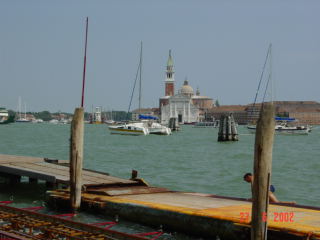
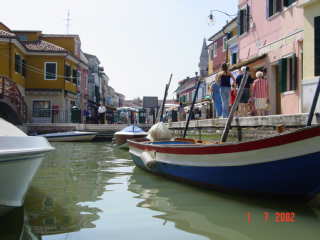 As Sue and Edie were close to arriving
we went back to Venice and secured a berth in St Elena Yacht
Club. So there we were again back
in the heart of
Venice
roaming the streets and marveling at the
beauty and richness of the buildings and, of course, finding out the best places
to shop for provisions. Sue and Edie duly arrived and after they had a look
around
Venice we headed south again to re-enter
Croatia
at the north and travel
slowly southwards. We stopped at the towns of Novigrad, Porec and Pula on the northern
Mainland of Croatia. All these towns have extensive ruins of old castles and
other fortifications. Pula, in particular, had a
large coliseum in an excellent state of repair and a Roman temple that was still
roofed. From Pula we sailed across to the
island of
Cres (pronounced Cresh) and
anchored in a little bay where we swam and snorkeled and of course ate and drank
too much. We experienced our first
"smoking water" phenomenon here and unfortunately it was not to be the only time
during the summer. An ominous dark
cloud appeared from behind island and moved toward us as the first strong gusts
hit us. I could see what looked like sand blowing across the water, but of
course, it couldn't be sand because there wasn't any. It was the surface of the
water being whipped up into a white mist by strong gusts rushing down the
valleys. We reckoned that it had to have a speed of 60 Kts to do
this.
As Sue and Edie were close to arriving
we went back to Venice and secured a berth in St Elena Yacht
Club. So there we were again back
in the heart of
Venice
roaming the streets and marveling at the
beauty and richness of the buildings and, of course, finding out the best places
to shop for provisions. Sue and Edie duly arrived and after they had a look
around
Venice we headed south again to re-enter
Croatia
at the north and travel
slowly southwards. We stopped at the towns of Novigrad, Porec and Pula on the northern
Mainland of Croatia. All these towns have extensive ruins of old castles and
other fortifications. Pula, in particular, had a
large coliseum in an excellent state of repair and a Roman temple that was still
roofed. From Pula we sailed across to the
island of
Cres (pronounced Cresh) and
anchored in a little bay where we swam and snorkeled and of course ate and drank
too much. We experienced our first
"smoking water" phenomenon here and unfortunately it was not to be the only time
during the summer. An ominous dark
cloud appeared from behind island and moved toward us as the first strong gusts
hit us. I could see what looked like sand blowing across the water, but of
course, it couldn't be sand because there wasn't any. It was the surface of the
water being whipped up into a white mist by strong gusts rushing down the
valleys. We reckoned that it had to have a speed of 60 Kts to do
this.
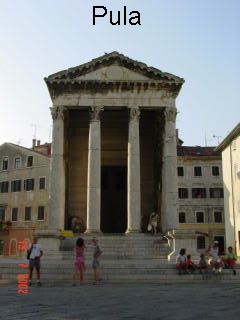
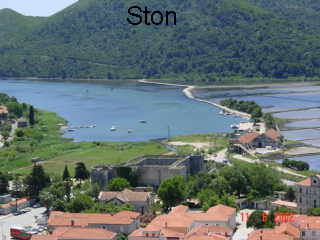 Our anchors held for the first half of
the blow but when the wind swung through 180 degrees they were unable to cope
and we had to start the motors quickly, pull in the anchors and motor around
until the wind eased and we could return and re-anchor safely. Sue and Edie
coped well in the face of this unexpected event with Edie sitting quietly below
while Sue helped me with the anchors.
Our anchors held for the first half of
the blow but when the wind swung through 180 degrees they were unable to cope
and we had to start the motors quickly, pull in the anchors and motor around
until the wind eased and we could return and re-anchor safely. Sue and Edie
coped well in the face of this unexpected event with Edie sitting quietly below
while Sue helped me with the anchors.
Next day we left for a nearby island called Otok Losinj and over the next
week or so made our way slowly southwards stopping at islands called names like
Otok Dugi, Otok Ugljan, Otok Iz and Otok Rava. We spent a couple of days in two
island groups that are designated parks called the Telascica National Park and the Kornati Group. The weather continued to be unsettled
and every night thunderstorms and lightning rolled around. The days were also
cool. We found a beautiful anchorage in the Kornati Group with white sandy
bottom and a little beach with a pebbly/sandy beach and spent one day swimming
before another front came through.
We had another unsettled night before heading off in the morning to find
a more protected anchorage. And so
it was that we found ourselves in a small keyhole shaped anchorage with about
ten other boats hanging on for three days and nights, doing anchor watches at
night and watching some of the other boats break their lines and end up on the
rocks or replacing their lines after they snapped or wore through. By then we had had enough and so we left
early for the mainland and hopefully a better
anchorage.
We passed a number of bays where smoking
water was happening and had a very hard slog across to the mainland into the
wind, but as we approached the shore the seas lessened although the wind stayed
up. Entered Kanal St Ante a deep
river with steep cliffs of rock on each side, and passed by Sibernik before
stopping in a little town called Zaton for
supplies.
We then headed further up the Kanal, Edie on the helm, Gail and Sue
looking nervous, and crossed a lake to a wonderful anchorage on the lakeshore,
which gave us protection from the wind.
We met up with our Kiwi friends on Minaret here. They told us that the
locals told them not to wander from the roads as there were anti personnel mines
everywhere. The water in the lake was brackish and had a fresh water layer on
the top so we washed some clothes and ourselves and had a good night's sleep
before heading up to Skadrin to see the Cascades higher up the river in the
Krk National Park. This was a delightful
little town but was scarred by bullet holes, and had a lot of young men with war
related injuries.
The Krk National
park was teeming with tourists but the old operating
water-driven felt-pounding and wheat-grinding mills were well worth the visit.
The cascades are covered with travertine formed when mosses and algae retain
calcium carbonate, encrusted in their roots.
We ventured out of the river and visited
a few more islands and bays as we continued to head south and a few days later
arrived in the town of Split. This is an old town with a huge palace
called the Diocletian Palace after the Roman Emperor. The area
within the walls still operates as a town with shops houses cafes and about 3000
residences. Stephen had a wonderful time exploring this town with Edie, going
down to underground museums and up a very high belfry, not to mention finding
fantastic ice creams, and a Maccas. We managed to have the odd beer and pizza
ashore for dinner and enjoyed the fire-jugglers buskin on the sea front at
night. Pizzas were about the only Croatian food that was OK, most of the meat
served up I wouldn't feed to my neighbours' dog and the rest was very bland not
to mention overpriced. After Split we headed for
the island of Hvar(pronounced Quar) to shelter from more
thunderstorms, then after a few days sailed to the island of Vis(pronounced Vish). Here we tried to
have dinner in the very nice garden restaurant, Villa Kaliopa, but found we had
to book days in advance, bugga!
Next island was Bisevo to visit the Blue Grotto, then the island of Brac. We sailed to Mljet Otok where we toured the lakes and an
old Benedictine monastery, then onto a bay that was great for swimming, and
making sand castles. We found beaches a rare commodity in Croatia. After a
few more island stops we ended up back in Dubrovnik.
We stayed in Dubrovnik until Sue and Edie
caught a ferry to Italy, another sad farewell. We then
sailed to Corfu, and slowly made our way south thru the Ionian Islands, until we ended up back in Trizonia. We were expecting Danny Vos, an
architect I had worked with in Darwin, join us
somewhere in the Greek Islands and so we made our way back through the
Corinth Canal and Saronic Gulf below Athens. In Poros we again met up with an
American couple, Randy, Sharon and their son Kai on their boat Uhane
Kai and an English/Spanish couple Darryl and Annie and their children Lisa and
Jay on La Liberte. We had a great feast of BBQ fish salad and baked bananas
before going our separate ways the next day. Uhane Kai and Gone Troppo headed to
Serifos to meet up with some English friends while La Liberte headed off towards
Athens.
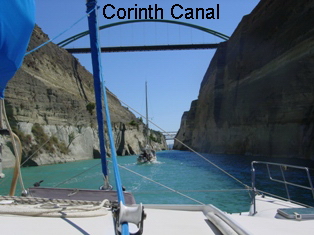
 Our email contact with Danny was proving
a bit touch and go but we managed to arrange with her to met at the
Island of Paros(home of the famous white marble) in the
Aegean
Sea. It was pretty windy when she arrived in
the middle of the night and the quay was unsafe so I picked her up in the dinghy
while Steve circled around outside the wharf area. She took it all in her stride
and we were soon safely anchored back in a protected anchorage about a mile
away.
Our email contact with Danny was proving
a bit touch and go but we managed to arrange with her to met at the
Island of Paros(home of the famous white marble) in the
Aegean
Sea. It was pretty windy when she arrived in
the middle of the night and the quay was unsafe so I picked her up in the dinghy
while Steve circled around outside the wharf area. She took it all in her stride
and we were soon safely anchored back in a protected anchorage about a mile
away.
Over the next couple of weeks we motored
and sailed through the Greek
Islands in the southern Aegean towards
Turkey. We were getting a bit keen to
be back in familiar waters as the autumn weather became more unpredictable but
we were glad we decided to visit the spectacular volcanic island of Santorini. It is thought that when this
island erupted in 1650BC it was three times as powerful as Krakatoa, and the
tasumi and ash ended the Minoan civilization. It maybe the fabled lost Atlantis
also. Certainly though, the volcano
has erupted severely over the past a couple of thousand years and islands have
been formed and then been destroyed. The landscape is bare jagged basalt and
layers of soft ash. The countryside is very fertile and they grow vines for
wine. The area is so windy,
however, that the vines are cultivated into a circle on the ground to protect
the grapes from the wind. The
buildings perch precariously atop the cauldron and seem set to slide into the
water below at the first tremor.

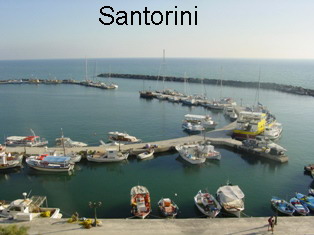 The wind increased again and so we had a brisk sail to Astipalia
sometimes doing 11 knots, but our sail towards Tilos, Simi and Rhodes Islands
was calmer and after a quick stock up of provisions that we knew were not
available in Turkey headed across to the Turkish mainland and arrived back in
Kemer a couple of days later after showing Danny some of the sights along the
way.
The wind increased again and so we had a brisk sail to Astipalia
sometimes doing 11 knots, but our sail towards Tilos, Simi and Rhodes Islands
was calmer and after a quick stock up of provisions that we knew were not
available in Turkey headed across to the Turkish mainland and arrived back in
Kemer a couple of days later after showing Danny some of the sights along the
way.
We were welcomed back and even got our
old spot back- the one near the bar-
I think they felt that Stephen would
have been upset if he was too far away.
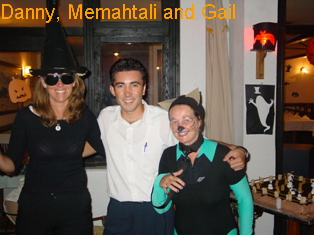
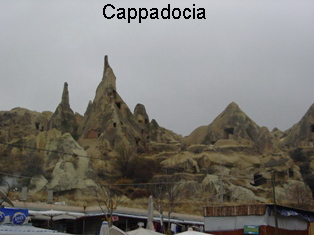 Danny celebrated Halloween with us dressed as a witch and I went as her
cat or familiar. Lots of fun as Randy and Sharon and their son Kai had turned
one room into a haunted house and there was a pumpkin carving competition. Sharon went as a head on a plate- very
gory.
Danny celebrated Halloween with us dressed as a witch and I went as her
cat or familiar. Lots of fun as Randy and Sharon and their son Kai had turned
one room into a haunted house and there was a pumpkin carving competition. Sharon went as a head on a plate- very
gory.
The marina is a fun place to be during
winter with many activities happening all the time. We went and had a complete physical,
something I had never had before and we both passed with the comment from the
doctor that we appeared to be 10 years younger than our actual ages so maybe
this sailing life is good for you.
We hired a car and met the Schallers in Izmir and spent a hectic but fun ten days touring inland
Turkey. Seeing Ephesus, Cappodocia and
the underground cities, as well as a stopover in Kemer. James had much fun, and
did very well, negotiating cheaper rates at the places we
stayed.
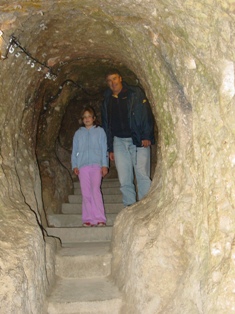
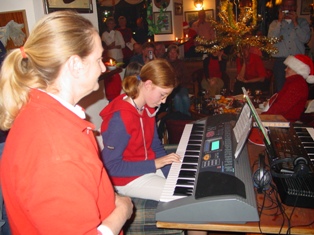 As this year draws to a close we would
like thank all those friends and family who keep in touch with us for their
welcome emails and calls through the year.
We hope everyone had a Merry Christmas and wish everyone a Happy and
Prosperous New Year.
As this year draws to a close we would
like thank all those friends and family who keep in touch with us for their
welcome emails and calls through the year.
We hope everyone had a Merry Christmas and wish everyone a Happy and
Prosperous New Year.
Lots of love,
Gail and
Stephen.
Gone Troppo
We found the boat safe and sound and we only lost 4 fenders during our
absence, which we considered a small price to pay for 6 months marina fees. We used the hire car to travel around
inland